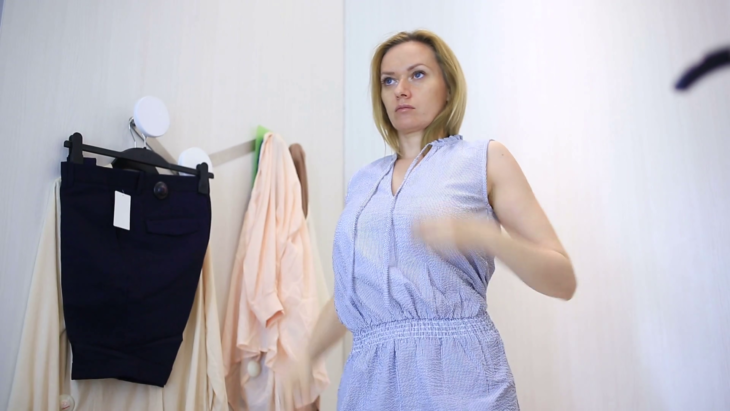This weekend I was wandering around one of my favorite stores when I spotted a sliver of blue plaid fabric peeking out from the crowded rack of dresses. Blue is my favorite color, and plaid is my favorite pattern, so I was immediately intrigued.
When I reached into the mass of hangers and pulled out the mysterious dress, there is a good chance I audibly gasped. It was lined in silk, with a cutout in the back, a sweetheart neckline, and a flowing hourglass shape. It was surprisingly formal, but the plaid fabric made it feel playful and fun. It was unique without trying too hard. It was, quite possibly, the most beautiful dress I’d ever seen. “I would pay $200 for a dress like this,” I thought, flipping over the price tag to reveal numerous crossed-out sale prices making their way toward a grand total of $39.97. I practically skipped to the dressing room.

Source: Phlox
Five minutes later, I slipped the dress over my head with the kind of fluttery anticipation typically reserved for a very promising first date. As I pulled it down over my hips, I was already envisioning our future together. I would pair it with my favorite slouchy boots for casual outings and black platform pumps for fancy dinner dates. This dress would travel the world with me. I would take it to London and wear it to high tea and possibly be mistaken for a short, blonde, voluptuous Kate Middleton. God, the silk lining felt so good against my skin. This dress was perfect. I spun around triumphantly and looked in the mirror.
It was the, quite possibly, the most unflattering dress I’d ever seen.
Everything about it was wrong: the fabric pulled across the shoulders and sagged beneath my bust line. The waist hung loosely in some places and bunched in others. The sexy cutout in the back gaped open awkwardly, like a surgical procedure a doctor had forgotten to stitch up. The length of the skirt made my legs appear to be the size and shape of pickle barrels. Even the plaid fabric, which had seemed so cool and funky on the hanger, suddenly seemed to be a poorly repurposed remnant from a pioneer family’s sewing scrap box.

Source: videoblocks
I examined my reflection in the mirror for a moment. Even the most talented tailor couldn’t salvage it; this dress and I simply weren’t meant to be. I was seriously bummed, but after giving myself a minute to mourn the loss of our future together, I slipped the dress off and reached for my jeans.
That’s when I was struck by the vague notion that I had forgotten something. Between entering the dressing room, trying on my dream dress, discovering it definitely wasn’t my dream dress, and putting it back on the hanger, something crucial was missing. I went back over the scene in my head, and suddenly the answer was glaringly obvious: I had forgotten to blame my body for a dress that didn’t fit.
Usually, my time in the dressing room is broken down as follows: 20 percent of the time is spent trying on clothes, and 80 percent of the time is spent berating my body for not fitting into the clothes the way I think it should. If a pair of jeans won’t button, it’s because my disgusting stomach is too fat, not because the jeans are too small. If a blouse gapes in front, it’s because my boobs are too big. If a dress sags below the waist, it’s because my hips aren’t curvy enough. If a jacket pulls across the shoulders, my broad shoulders are to blame. You can imagine how, after trying on a variety of garments with this mindset, I could easily give myself the ammunition to hate every single part of my body. Often, that’s exactly what happens: I can’t count how many times I’ve stood under those unforgiving fluorescent lights in my bra and underwear, glaring at my reflection with a fiery hatred I would hesitate to unleash on my worst enemy.

Source: Pexels
When I tried on that beautiful blue plaid dress, the stage was set for a body-hating bonanza. I mean, it really did look horrific on me, and perhaps if I had longer legs, smaller boobs, slimmer shoulders, and a drastically different waistline, it would have looked amazing. But something had shifted in my way of thinking, because instead of berating my body for not fitting the dress, I realized that the dress didn’t fit my body, and I moved on.
And damn did that feel good.
Maybe it was the body image revelation I had in Hawaii this summer. Maybe it’s just another milestone on the path I’m slowly but surely forging toward self-acceptance. Whatever the reason, that not-so-perfect dress showed me that I’m done using clothing as a reason–an excuse, really–to judge my body. Sometimes clothes fit, sometimes they don’t. My body is the constant. My body deserves better.
When I handed the dress back to the dressing room attendant, she frowned. “Didn’t work out for you, huh?” she asked.
“Nope,” I said, but I couldn’t help smiling about something that had worked out: I didn’t love the dress, but I’m finally starting to love myself.
Original by Winona Dimeo-Ediger
